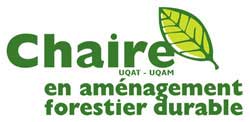Lisa Bajolle, Yves Bergeron, Isabelle Larocque, Emmanuel Gandouin, Martin Lavoie, Adam A. Ali. A chironomid-inferred Holocene temperature record
from a shallow Canadian boreal lake: potentials and pitfalls. 2019. J Paleolimnol 61(1):69-84
DOI : 10.1007/s10933-018-0045-9
The biodiversity of shallow (zmax?
Lisa Bajolle, Isabelle Larocque, Emmanuel Gandouin, Yves Bergeron, Adam A. Ali, Martin Lavoie. Major postglacial summer temperature changes in the central
coniferous boreal forest of Quebec (Canada) inferred using
chironomid assemblages. 2018. Journal of Quaternary Science 33(4):409-420
DOI : 10.1002/jqs.3022
Chironomid head capsules preserved in lake sediments were used to reconstruct 8200 years of summer temperatures in the boreal forest of north?eastern Canada. Two training sets were used derived from Canadian and Eastern Canadian transfer functions. Both models reconstructed similar climate patterns, but the Canadian model provided temperatures generally 2–3?°C lower than the Eastern Canadian model. Three main thermal changes inferred by chironomids were: (i) the Holocene Thermal Maximum, which occurred between 8 and 5k cal a BP, with temperatures generally higher than today's, maximum temperatures between 8 and 6.5k cal a BP, and an average of?+?0.9?°C; (ii) the Medieval Climate Anomaly around 1.1–1.2k cal a BP with an amplitude of?+?0.7?°C; and (iii) a colder period reconstructed between the 14th and 19th centuries, corresponding to the Little Ice Age, with summer temperatures on average ?0.5?°C lower than the climate normal. For each of these three climatic events, the timing and the amplitude of changes were similar with other published regional, North American and Northern Hemisphere records.
Isabelle Larocque, Yves Bergeron. Fire-induced decrease in forest cover on a small rock outcrop in the Abitibi region of Quebec, Canada. 2003. Ecoscience 10(4):515-524.
Rocky outcrops represent about 30% of the boreal forest of Abitibi, Quebec, Canada. Although these outcrops have similar edaphic and climatic conditions, their vegetation can vary. Some are composed of a closed forest of black spruce (Picea mariana) and eastern white cedar (Thuja occidentalis), while others support open Pinus-dominated stands. A long-term study using palynology and charcoal analysis was used to determine the processes involved in creating the open vegetation observed on one outcrop located at Roquemaure. Changes in the fire regime through time seem to be the explanatory factor. Vegetation on this outcrop started 3,775 calibrated years ago as a closed Picea mariana-dominated stand. Increase in fire frequency ca 1,465 calibrated years ago led to the replacement of the Picea mariana-dominated stand by the more open Pinus woodland observed today. Changes in climate from wet to dry might explain this increase in fire frequency. Dry soils and exposed bedrock created by climate change and increased fire frequency limited the regeneration of Picea mariana. For future landscape management, long-term studies should be taken into consideration to determine the natural variability of ecosystems.
Isabelle Larocque, I.D. Campbell, R.H.W. Bradshaw, Yves Bergeron. Modern pollen-representation of some boreal species on islands in a large lake in Canada. 2000. Review of Paleobotany and Palynology 108(3-4):197-211.
Studies of pollen source areas of closed-canopy sites are contradictory. Some authors found that closed-canopy sites mainly collect local pollen while others found more distant sources. This dichotomy might stem from the use of canopies of varying degrees of closure, and from variations in the pollen productivity of the local vegetation and the background pollen rain. Here, 30 islands were used to evaluate the pollen sources of closed-canopy sites. We compared pollen with the forest inventory in three quadrat sizes: 100, 400 m2 and on the whole island. Regression analyses showed that most pollen of Picea spp., Pinus spp., and Betula spp. comes from within the 400 m2 quadrat. Abies balsamea and Thuja occidentalis showed no relationship with vegetation in any of the quadrats considered, suggesting a more regional source. Insularity and island size are important factors influencing the pollen source area; correlations were stronger on islands located 1200 m from the nearest shore and on islands > 50 ha. These results suggest that closed-canopy sites on islands may be useful in stand-level vegetation history reconstruction through pollen analysis, but that caution must be exercised in separating the local and regional signals. (C) 2000 Elsevier Science B.V. All rights reserved.
voir la liste complète

